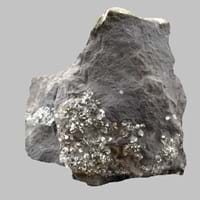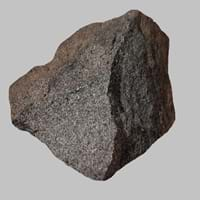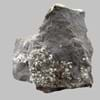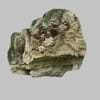Definition
Argillites are highly compact sedimentary or slightly metamorphosed rocks that consist largely or wholly of particles of clay or silt but lack the fissility of shale or the cleavage characteristic of slate
Vogesite is a porphyritic alkaline igneous rock and is a variety of Lamprophyre which is dominated by essential amphibole, usually hornblende, and potassic feldspar
Discoverer
Unknown
Unknown
Etymology
From Latin Argilla (clay) and -ite in English which became agrilla+ -ite = Argillite
From the variety of Lamprophyre Greek lampros bright and shining + porphureos purple
Class
Sedimentary Rocks
Igneous Rocks
Sub-Class
Durable Rock, Soft Rock
Durable Rock, Medium Hardness Rock
Group
Not Applicable
Plutonic
Other Categories
Fine Grained Rock, Opaque Rock
Coarse Grained Rock, Fine Grained Rock, Opaque Rock
Texture
Clastic, Polished
Porphyritic
Color
Dark Grey to Black, Pink, Red, White
Black, Bluish - Grey, Brown, Dark Greenish - Grey, Green, Grey
Durability
Durable
Durable
Scratch Resistant
Yes
Yes
Appearance
Rough and Dull
Dull, Banded and Foilated
Interior Uses
Decorative Aggregates, Homes, Interior Decoration
Decorative Aggregates, Entryways, Flooring, Homes, Interior Decoration
Exterior Uses
As Building Stone, Garden Decoration, Office Buildings
As Building Stone, As Facing Stone, Garden Decoration, Office Buildings, Paving Stone
Other Architectural Uses
Curbing, Whetstones
Curbing
Construction Industry
Used for flooring, stair treads, borders and window sills.
As Dimension Stone, Cement Manufacture, for Road Aggregate, Making natural cement, Manufacture of Magnesium and Dolomite Refractories
Medical Industry
Not Yet Used
Taken as a Supplement for Calcium or Magnesium
Antiquity Uses
Artifacts, Monuments, Sculpture
Artifacts, Monuments, Sculpture
Commercial Uses
Fire resistant, Used to manufracture paperweights and bookends
An Oil and Gas Reservoir, As a Feed Additive for Livestock, Gemstone, Metallurgical Flux, Production of Lime, Soil Conditioner, Source of Magnesia (MgO)
Types
Not Available
Minette, Alnoite, Camptonite, Monchiquite, Fourchite, Vogesite, Appinite and Spessartite
Features
Is one of the oldest rock
Always found as volcanic pipes over deep continental crust, Host rock for Diamond, Is one of the oldest rock, Surfaces are often shiny
Archaeological Significance
Famous Monuments
Data Not Available
Data Not Available
Famous Sculptures
Data Not Available
Data Not Available
Formation
An argillite is a fine-grained sedimentary rock mainly composed of clay particles which forms from lithified muds which contain variable amounts of silt-sized particles.
Vogesite formation takes place deep beneath the Earth’s surface at around 150 to 450 kilometres, and are erupted rapidly and violently.
Mineral Content
Biotite, Chlorite, Feldspar, Micas, Muscovite or Illite, Plagioclase, Pyrite, Quartz
Amphibole, Carbonate, Garnet, Micas, Olivine, Phlogopite, Pyroxene
Compound Content
Iron(III) Oxide, Potassium Oxide, MgO, Silicon Dioxide
Aluminium Oxide, NaCl, CaO, Iron(III) Oxide, FeO, Potassium Oxide, MgO, MnO, Sodium Oxide, Silicon Dioxide, Titanium Dioxide
Types of Metamorphism
Not Applicable
Burial Metamorphism, Cataclastic Metamorphism, Contact Metamorphism, Hydrothermal Metamorphism, Impact Metamorphism, Regional Metamorphism
Types of Weathering
Biological Weathering
Biological Weathering, Chemical Weathering, Mechanical Weathering
Types of Erosion
Chemical Erosion
Chemical Erosion, Coastal Erosion, Glacier Erosion, Sea Erosion, Water Erosion, Wind Erosion
Grain Size
Fine Grained
Fine to Coarse Grained
Fracture
Conchoidal to Uneven
Conchoidal
Streak
White to Grey
White
Porosity
Highly Porous
Very Less Porous
Luster
Waxy and Dull
Subvitreous to Dull
Cleavage
Slaty
Conchoidal
Toughness
2.6
Not Available
Specific Gravity
2.56-2.68
2.86-2.87
Transparency
Opaque
Translucent to Opaque
Density
2.54-2.66 g/cm3
2.95-2.96 g/cm3
Specific Heat Capacity
Not Available
Resistance
Heat Resistant, Impact Resistant
Heat Resistant, Impact Resistant
Deposits in Eastern Continents
Asia
Bangladesh, China, India, Russia
Russia
Africa
Ethiopia, Kenya, Morocco, South Africa, Tanzania
Angola, Botswana, Cameroon, Ethiopia, South Africa
Europe
Austria, France, Germany, Greece, Italy, Romania, Scotland, Spain, Switzerland
England, Hungary, Iceland, United Kingdom
Others
Not Yet Found
Antarctica, Greenland
Deposits in Western Continents
North America
USA
Canada, Mexico, USA
South America
Bolivia, Chile, Colombia, Ecuador, Peru, Venezuela
Argentina, Colombia, Ecuador
Deposits in Oceania Continent
Australia
New South Wales, New Zealand, Queensland, Victoria, Western Australia
New South Wales, New Zealand, Queensland, South Australia, Western Australia
Argillite vs Vogesite Characteristics
Though some rocks look identical, they have certain characteristics which distinguish them from others. Characteristics of rocks include texture, appearance, color, fracture, streak, hardness etc. Argillite vs Vogesite characteristics assist us to distinguish and recognize rocks. Also you can check about Properties of Argillite and Properties of Vogesite. Learn more about Argillite vs Vogesite in the next section. The interior uses of Argillite include Decorative aggregates, Homes and Interior decoration whereas the interior uses of Vogesite include Decorative aggregates, Entryways, Flooring, Homes and Interior decoration. Due to some exceptional properties of Argillite and Vogesite, they have various applications in construction industry. The uses of Argillite in construction industry include Used for flooring, stair treads, borders and window sills. and that of Vogesite include As dimension stone, Cement manufacture, For road aggregate, Making natural cement, Manufacture of magnesium and dolomite refractories.
More about Argillite and Vogesite
Here you can know more about Argillite and Vogesite. The life cycle of a rock consists of formation of rock, composition of rock and transformation of rock. The composition of Argillite and Vogesite consists of mineral content and compound content. The mineral content of Argillite includes Biotite, Chlorite, Feldspar, Micas, Muscovite or Illite, Plagioclase, Pyrite, Quartz and mineral content of Vogesite includes Amphibole, Carbonate, Garnet, Micas, Olivine, Phlogopite, Pyroxene. You can also check out the list of all Sedimentary Rocks. When we have to compare Argillite vs Vogesite, the texture, color and appearance plays an important role in determining the type of rock. Argillite is available in dark grey to black, pink, red, white colors whereas, Vogesite is available in black, bluish - grey, brown, dark greenish - grey, green, grey colors. Appearance of Argillite is Rough and Dull and that of Vogesite is Dull, Banded and Foilated. Properties of rock is another aspect for Argillite vs Vogesite. The hardness of Argillite is 2-3 and that of Vogesite is 5-6. The types of Argillite are Not Available whereas types of Vogesite are Minette, Alnoite, Camptonite, Monchiquite, Fourchite, Vogesite, Appinite and Spessartite. Streak of rock is the color of powder produced when it is dragged across an unweathered surface. The streak of Argillite is white to grey while that of Vogesite is white. The specific heat capacity of Argillite is 0.87 kJ/Kg K and that of Vogesite is Not Available. Depending on the properties like hardness, toughness, specific heat capacity, porosity etc., rocks are resistant to heat, wear, impact, etc.Argillite is heat resistant, impact resistant whereas Vogesite is heat resistant, impact resistant.





